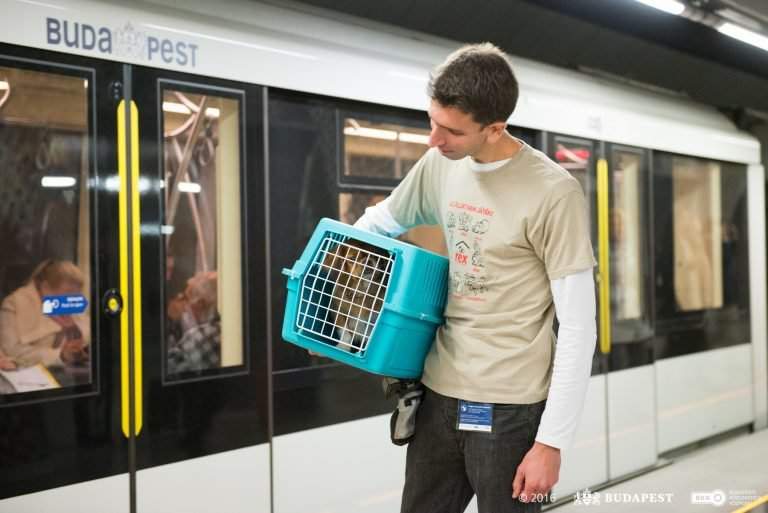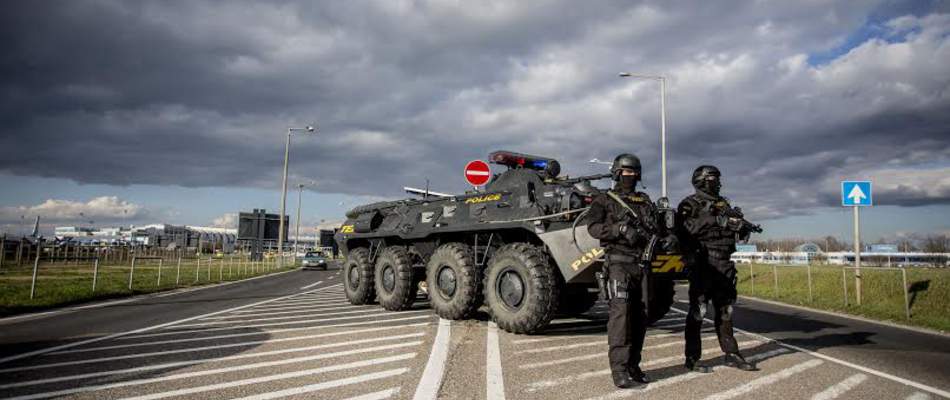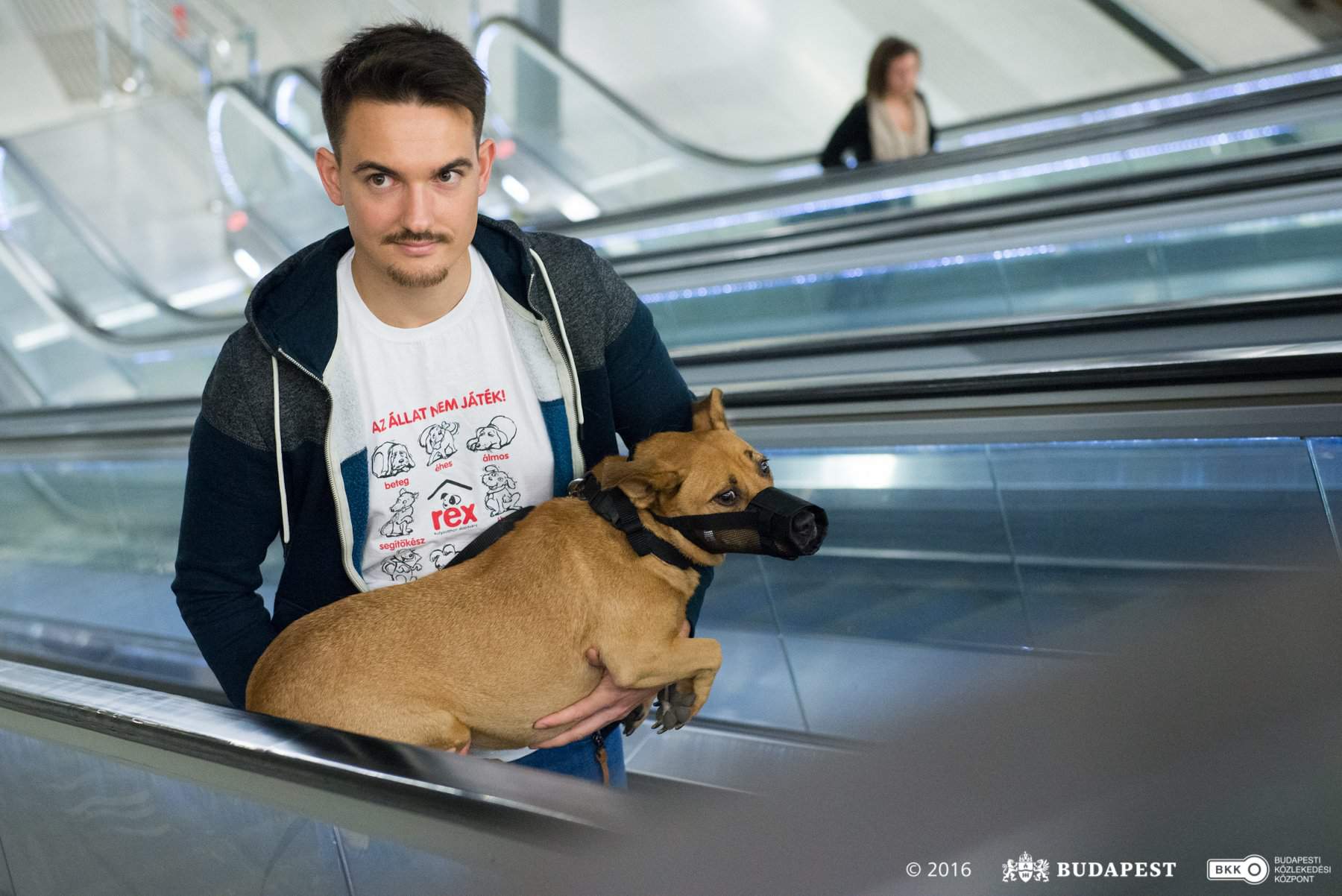Information guide on how to travel with dogs on public transport in Hungary
Despite the fact that a great number of passengers use public transport services in the company of their four-legged pets, many of the travellers are unaware of the rules for transporting dogs. The Rex Dog Shelter Foundation along with BKK Centre for Budapest Transport presented the know-how of transporting dogs on board public transport vehicles so as to ensure the safety of pets and passengers alike.
 Did you know that dogs are not allowed to travel on a seat but only on the floor of the vehicle? Did you also know that you need to carry your dog’s valid vaccination certificate when you travel together? Are you aware of the fact that the escalator is the main safety hazard and primary cause of accidents for your pet, which is why the dog needs to be carried in your arms?
Did you know that dogs are not allowed to travel on a seat but only on the floor of the vehicle? Did you also know that you need to carry your dog’s valid vaccination certificate when you travel together? Are you aware of the fact that the escalator is the main safety hazard and primary cause of accidents for your pet, which is why the dog needs to be carried in your arms?
On the one hand, to disseminate knowledge about the rules for transporting dogs to as many passengers as possible and on the other hand, to present jointly with the Rex Dog Shelter Foundation, whose credo is responsible pet ownership, how these rules are applicable in practice. These rules serve the safety of both passengers and pets, therefore they need to be kept by all responsible pet owners.
How to travel with dogs?
At the press conference jointly held by the Rex Dog Shelter Foundation and BKK Centre for Budapest Transport, interested participants were informed, among others, about the following topics:
How can dogs be transported on board BKK’s vehicles?
Small-sized dogs can be transported either in a closed, hand-luggage-sized carry-box, in a sim_3999cage or in a bag which prevents the animal from jumping out and from dirtying other passengers’ clothes or luggage or the vehicle itself. In every other case – regardless of age, breed or size – dogs are allowed to be transported only when muzzled and on a lead.
What qualifies as a muzzle?
Any type of device made of metal, plastic, textile, etc. is accepted as a muzzle that prevents unwanted biting or keeps the dog from damaging other passengers or items aboard the vehicle with its teeth. (The HALTI brand headcollar does not meet this criterion.)
Are dogs allowed to be transported in your hands?
Yes, but the dog still needs to be muzzled and on a lead.
What types of tickets or passes are required for transporting dogs?
It is required to validate a full-price ticket for the given journey for the dog (a public transport boat ticket for scheduled riverboat services, a full-price ferry ticket for ferry transport, a single ticket or a block of ten tickets or a transfer ticket for the entire route of any public transport line can be purchased, while a suburban railway extension ticket for the route section outside the administrative boundaries of Budapest, and a metro section ticket on the metro network for up to three stops can be also used), but passengers also have the option of purchasing a 24-hour, 72-hour, weekly or 5/30 BKK 24-hour travelcard or a monthly dog pass for their dog. With one dog pass, the transportation of only one dog is allowed, no pass ID is necessary. Of course, the passenger carrying the dog is required to be in possession of a valid ticket, pass or other travel certificate as well.

Can dogs be transported free-of-charge?
Dogs carried as hand luggage in a closed container do not require a separate ticket or pass. sim_3940Police dogs, guide dogs, assistance dogs for individuals with a disability (visually, physically or hearing impaired customers), signal dogs and seizure alert dogs travel for free.
How many dogs are allowed to be carried by one passenger?
One dog per passenger is allowed.
What are the rules for transporting dogs on an escalator?
The primary safety hazard for dogs is the sim_3863escalator as the transport device is capable of catching the dog’s paws and damaging its hair or claws. Therefore, in order to ensure the dog’s safety, it must be carried in the passenger’s arms when travelling on the escalator, especially when stepping onto and off the escalator. In case of big-sized dogs, after alerting the station staff on duty, the non-moving back-up escalator must be used, if possible.
What documents must passengers have on them when transporting a dog?
Passengers need to be in possession of their dog’s valid vaccination certificate which must be presented to the staff on duty, if requested.
Photo: bkk.hu
Source: BKK Centre for Budapest Transport – press release
please make a donation here
Hot news
Top Hungary news: train derailed, huge tax against short-term rentals, new train stations, Hungarians about the war, Dracula, cocktail bars — 21 October, 2024
Hungarian research could yield breakthrough in Covid-19 treatment
5+1 stylish cocktail bars in Budapest to explore with your friends after a long day
Railway stations in major Hungarian cities to be completely rebuilt with private capital
Young people planning armed attacks against protected persons in Hungary – US intelligence warns
Hungary, Laos agriculture ties strengthening: Minister Linkham Duangsavanh visits Budapest





